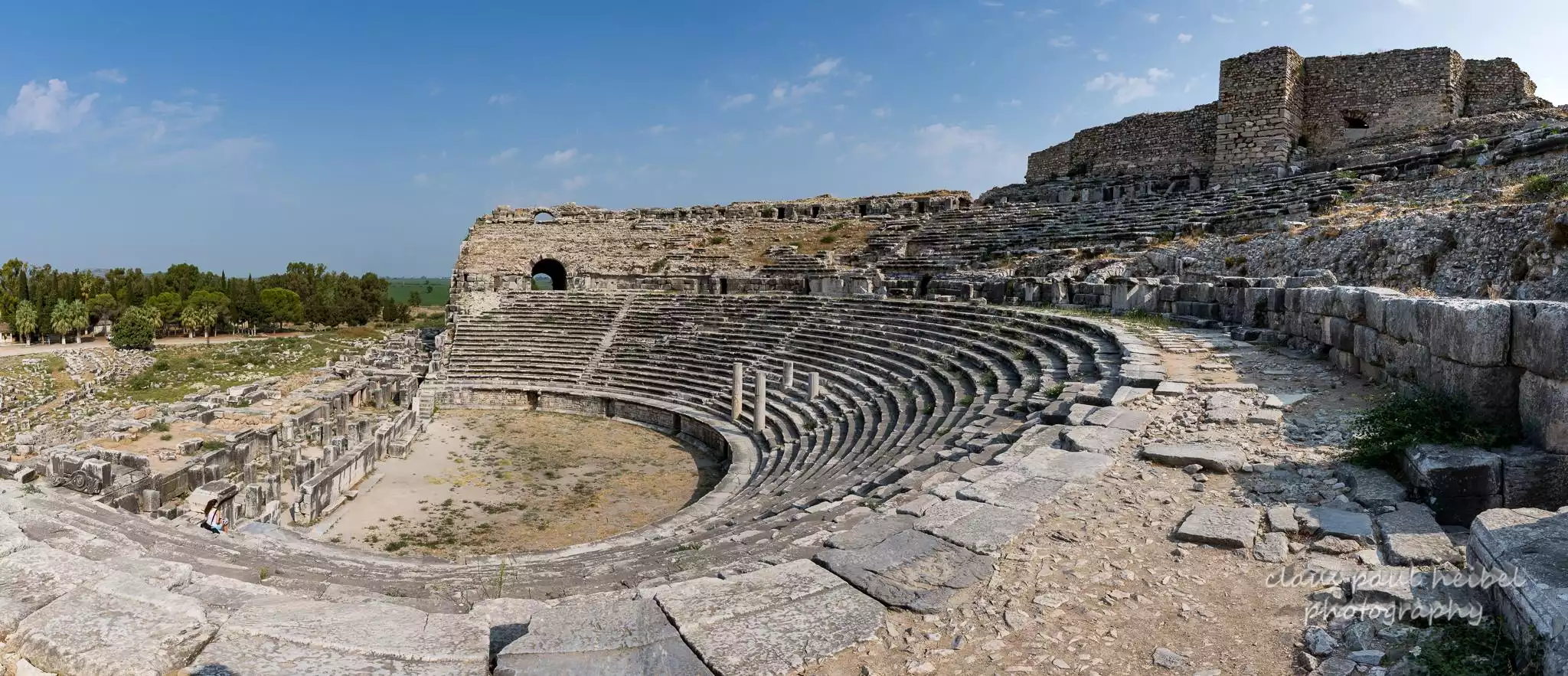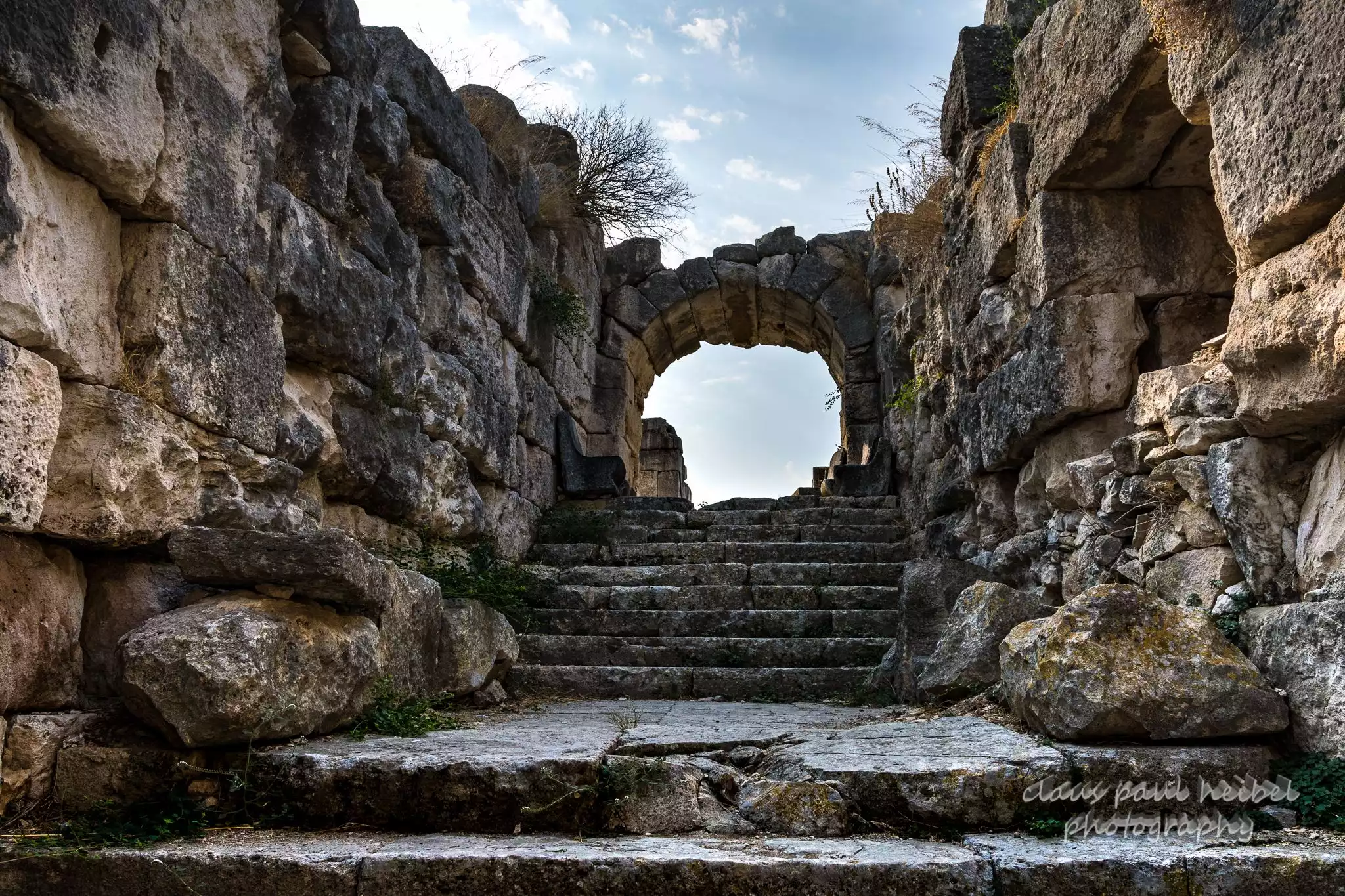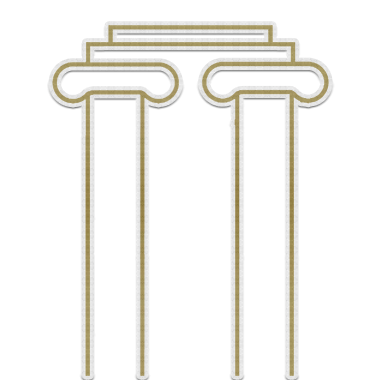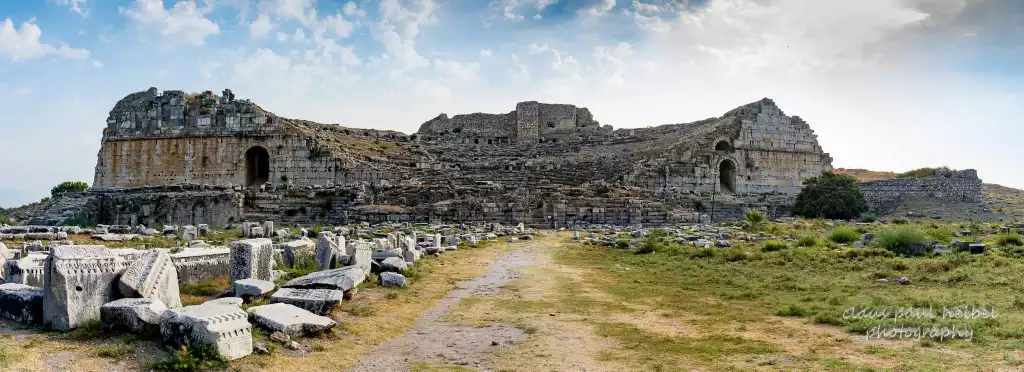The City Of Thales
MILETUS – MILETOS – Milet
Milet Theatre from air Miletus is situated in Soke’s Balat village. In ancient times it was on the coast and the most famous of Ionian harbours. Its name in Hittite records was Millawandash. It was famous in the classical period which the scholars called “fusiolog”. Herodotus wrote that it was founded by the Cretans and Carians.
Milet Ancient Town theatre building with Byzantine castle on top
It was an important Micanean colony towards the middle of 2000 B.C., however in the 7th century B.C. it had more than 80 colonies from the farthest corners of the Mediterranean and the Black Sea. After its destruction by the armies of Darius in 494 B.C. it was reconstructed. It was under Persian rule for two centuries. With the conquest of Alexander the great, it became one of the greatest metropolis of Aegean Anatolia and remained its importance during the Roman period as well. In the Byzantine period despite the fact that the sea. had withdrawn, the commercial port could still be used thanks to the ships which sailed through the Menderes river. Because the remains of antique building resembled palaces. It went by the name Palatia for some time; and during the last days of Byzantine rule, it became a shelter of pirates.
Visiting Milet a pass way between stoa to agora Eventually in the 8th century it was converted into a Turkish town by the Mentese principality as “Turkish Balat’, although it went through a period of splendour during the rule of Menteseogullari gradually losing its importance, it turned into a small village in the 18th century and the village mentioned here was moved elsewhere after the 1955 earthquake.
The systematic archaeological digs in Miletus were started by T.Wiegand in 1899, Carl Weickerd headed the one in 1939 and the latest ones took place under the direction of G. Kleiner.

Milet antik kenti Tiyatro liman
Most of the works of art found in the excavations during the Ottoman rule, unfortunately are to be found in foreign museums now. Miletus which had a very important in history, was completely destroyed by frequent raids and disasters and thus does not have too many relics left with the exception of its theatre and Faustina Baths, some of the relics left can be listed as follows.
Archaic period relics: The archaic relics belonging to the old Miletus, destroyed by the Persians were found around Kalabak Hill. The temple of Athena can be classified as fifth century B.C.
The Theatre: It is one of the oldest theatres of western Anatolia, built in fourth century B.C., renovated in the Hellenistic period and a stage building was added in the Roman period. Use was made of a natural incline of a slope in the selection of its location. Its front facade was 140 meters, proscenium 230 meters and stage was 34 meters long, the capacity of seating in the cavea was 15.000 , and of the four columns of the king’s box behind the orchestra only two are left. The skene built in the Roman period was a three storey building with columns and statues.
The Southern Agora: It is the largest of the three agora’s of Miletus, started in the Hellenistic period, and completed in the Roman period, surrounded by long stoas with columns. Its monumental door was taken to Berlin and was reconstructed there.
Serapis Temple The Faustina Baths: These baths, bunt in the reign of the Emperor Aurelius, and located between the theatre and the southern agora, are well preserved. Such parts as apoditerium, frigidarium and caldarium which were the main sections of Roman baths were very well-planned. Some of the statues found in the excavations were taken to the archaeological museum in Istanbul and some remained on the premises.
The Stadium: It is between the theatre and the harbour. It’s believed that it had a capacity of seating 15.000 people in athletic races.
Bouleterion: It had a courtyard surrounded by columns which was entered through the propylon and into the covered auditorium. It was built in the 2nd century B.C. and has a capacity for seating 1500 people.
The ceremonial Path and Ionic Stoa: A path going from the Bouleterion to the harbour, a stoa whose restoration was started in 1976 is place east of the ceremonial path. Behind this was a lean-to with 35 ionic columns containing 19 shops. Ceremonies were held along this street.
Nymphanon: It was built during Emperor Titus reign in 70 A.D, a monumental three storey building 20 meters in length and 17 meters high, filled with statues placed between columns. Water flowed from the mouths of the slanted anaphora’s and fish statues on the first floor.
Delphinium: It was a temple dedicated to Apollo Delphinus, with traces of religious relics dating back to the archaic age. It was built in the Hellenistic age and renovated in the Roman period. The temple area was encircled with Doric stoas in Hellenistic period and Corithiai in the Roman period.
Gymnasium: It is east of the North agora and is entered by a stair with four steps. From a big door, halls surrounded by Doric and Ionian columns are entered. It has a courtyard around which there are five exercise-rooms.
Serapis Temple: It was built in the 3rd century A.D. formed of 5 columns in two rows. The walls of cut stone, date back to earlier times.
The Byzantine Tower: It was built during the Byzantine period on the hill on whose slopes stood the theatre building. Many of the ramparts of the castle which was used both by the pirates and the Turks, were built over the theatre. During the first excavations while the theatre was being cleaned, many of these were taken away.
The Great Church: It was built in 534 on a foundation of 3rd century B.C. and another one of 2nd century A.D. The floor mosaics of the Martyrion and baptizing rooms are in the Miletus museum.
As for the buildings belonging to the Menteseogullari period in the ruins of Miletus, they are as follows:

Milet antik kenti Tiyatro liman
Ilyas Bey Mosque and complex: The mosque, forming a complex with its seminary and baths, is based on a square plan with a single dome, and measures 18.30 X 13.30 meters. Its walls are covered with a finely ornamented marble both from the inside and outside. The northern entrance has the appearance of a crown door with its pointed and arched niche. Within this niche, mounted on two columns and with frontal pieces are three low-arched passages. The passages on both sides are made into windows with very delicately wrought marble work and the central passage forms the entrance of the mosque.
The whole structure was woven first from the walls to an octagonal bracelet with stalactite trumps and then to the tile-covered dome. The altar is an example of exquisite marble workmanship. The pulpit, of equal craftsmanship, was taken to Ilyas Aga Mosque in Soke towards the end of the 19th century.
The Caravanserai: It Is a rectangular building measuring 24 X 30 meters. The toner courtyard encircled by vaulted rooms measureslO.67 X 16.09 meters. A stairways leads to the second floor of the caravanserai.
The Turkish Baths: It is squeezed between the Ionic stoas of the antique age, measures 24 X 18 meters. The various ship drawings on its walls drawn by sailors are of interest.
The Mosque of forty steps: It was built of rubble stones in the 14th century. Its name comes from the fact that there are forty steps outside its wall leading to the minaret.
The Miletus Museum, a local museum on a small scale was opened in 1973 under the auspices of the general Directory of antiques and Museums, mainly for the purpose of exhibiting the archaeological findings dug up in Miletus. It consists of a hall with a pool opening into the main hall and another smaller
Miletos Ceramics dating back to the 15th century B.C. and belonging to the Mycenae period are on exhibit in the main hall, and in the show cases behind them, small items and ceramics belonging to archaic, classical. Hellenistic and Roman periods are exhibited. Between the stands and window cases are mosaic pieces and statues of the same periods. The small hall exhibits objects starting from the Roman period, to the Byzantine, Seljuk and Ottoman periods. Here coins of all periods are available as well. Tombstones and pieces of mosaic are nailed to the walls of the hall with the pool. On each side of the door of the main hall two Branchid statues are placed and other parts of the hall are decorated with statues, tombstones and architectural pieces. The other bigger pieces and statues are exhibited on the colonnaded terrace around the museum and in the garden.
IONIAN THINKERS
In the 6th century B.C. Ionia produced a number of thinkers who devoted themselves to the study of the universe and the discovery of the laws of nature. In this way they broke the chains of religion and bigotry which had existed up to that time and showed that natural phenomena were governed, not by mysterious forces but by natural laws.
HERACLEITUS (540-480 B.C.)
Heracleitus was born and brought up in Ephesus. He concentrated on the problem of existence. He believed that fire was the essence of the universe, and also believed in the transitory nature of all things, the apparent permanence and stability of things within this actual transistorises being mere illusion. The appearance of permanency arises from the fact that change is governed not by chance but by certain laws and takes place in accordance with a certain order. Heracleitus named this order “LOGOS”. The universe is governed by law and it is the task of reason to discover this law.
ANAXAGORAS
A native of Clazomenae (Guladasi), Anaxagoras was one of the most important of the 5th century thinkers. In 462 he went to Athens, where he spent the next thirty years of his life. He won fame as a mathematician, while at the same time making some very important discoveries in astronomy. He explained the problem of the light from the moon and of the eclipse of the sun and moon.
According to Anaxagoras there were many elements distinguished by different qualities produced not by the entry into the compound of new elements but by the separation of elements in the compounds.
He introduced the idea of the atom and its possible separation. He was sentenced to death in Athens for denying the divinity of the sun and moon and declaring that they consisted of masses of material.
XENOPHANES (569-477 B.C.)
A contemporary of Heracleitus, Xenophanes was a native of the city of Colophon. He might be regarded as a religious teacher rather than a philosopher.
He opposed the anthropomorphic approach to the gods. He believed in a single god of a wholly intellectual nature, a philosophical approach that constituted the first step on the road towards monotheism.
DEMOCRITUS (460-390 B.C.)
Democritus was a native of Teos. Only a few fragments of his works have survived. He declared that a single scientific discovery was worth more than being King of Persia. According to Democritus, nothing disappears or changes its form, it always remains the same. But besides being, there is also non-being, i.e. empty space. According to Democritus, matter is composed of indivisible, invisible particles distinguished in form, position in space, size and weight. These particles Democritus called “atoms”.
Democritus thus laid the foundations of a mechanist approach to natural philosophy, but in ancient times his views were to remain undeveloped. His approach to natural philosophy was taken up again only at the beginning of the modern age. He was the first to discover the law of cause and effect.
THALES (625-545 B.C.)
Thales is recognised as the founder of Western philosophy. He believed that water formed the essence of matter, and is renowned for having forecast the eclipse of the sun that took place on the 28 May 585 B.C. None of his writings have survived. He advised sailors to take their bearings from the LITTLE DIPPER rather than the BIG DIPPER formed by the northern stars. He is said to have used geometry to calculate the height of the Egyptian pyramids and the distance of a ship from the shore. He is universally agreed to have foreseen the eclipse of the sun which brought the battle between the Lydian King Alyattes and Cyaxares, King of the Medes, to an end. He was the discoverer of a number of geometrical theorems. 1. The diameter divides the circumference into two equal sections, 2. The two angles at the base of an isosceles triangle are equal, 3. The opposite angles at the point of intersection of two straight lines are equal. 4. Two straight lines from a point on the circumference of a circle to the ends of the diameter form a right angle. Thales’ material approach to the universe constituted a break with traditional mythological explanations. Both sides in the battle mentioned above broke off hostilities in the belief that this was a sign from the gods. Thales had calculated the time of the eclipse beforehand and informed the Lydian’s accordingly.
Todays car park is located where former coastline silted up with alluvial deposits of the river meander.
Travel Tips:
Camera, Comfortable shoes, hat, bottled water and cash money are the musts… Between Soke and Didim Central there are no cash machines. If You are travelling by rental car, etc. There are many petrol stations on both sides of the road.
Milet and Priene Road also the place where River meander meets the Aegean. You can view endangered species of birds according to the season.
Drivers travelling from Bodrum should turn left from the second juncktion (three way called Ak-Yenikoy Dalyani) After passing a modern village Ak-yenikoy you will be climbing towards strawberry fields and vineyards up to an Old Greek Village called Akkoy where you can take more information about your trip to Didim Region.
Local Coach Company Didim Seyahat has regular services from / to Soke in every 15 minutes during the summer season.
In winter or early spring time table changes. You can drop off from the midibus at the village Akkoy and walk for half an hour to Miletos or You can take Balat Birlik minibusses runs in every hour.
If You try to get to Priene in the same day you can go to Soke and take Gullubahce Belediyesi minibusses from Soke to Priene in every 15 min. first. Then you can take midibusses to Balat (Milet).
If you think that you have and would like to see more, try old Gullubahce where St. Nikolaos Church is located worth seeing. Just after 10 Minutes of walk from Priene, ask for Eski Gullubahce.
If you are accommodating at Bodrum or Kusadasi or Altinkum, Tour Operators and Local travel agents also organize Milet- Priene-Didyma tour as Daily Excursion in their tour program.
important tip:
There are regular minibus transport service between Akkoy and Milet.
BALAT BIRLIK MINIBUSSES IN EVERY 20 MINUTES
You can visit our Art Gallery Cafe Olive for more information open between 09:00 am 19:00 pm all week days including Sundays all year around winters and summers.
important tips while visiting Milet Ancient Town:
There’s regular minibus transport service between Akköy and Milet. Balat Birlik minibuses in every 20 minutes.
If you are travelling individually and if you think you cannot manage to walk to milet (which is 3-4 kilometres far from Akkoy) don’t worry. You can come in to our Art Gallery Cafe Olive for more information open between 09:00 am 19:00 pm all week days including Sundays all year around winters and summers.
 Didim Guide
Didim Guide




